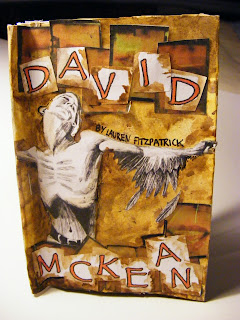Contextual Study: David Mckean
David Mckean is an English Illustrator who has won numerous awards for his works. These works include graphic novels, CD covers, book covers and short comics. However, he has also produced a series of illustrated playing cards, post cards and even tarot cards. Mckean’s works are most recognisable for the range of media he uses; he incorporates the use of collage, photography, painting, sculpture, drawing and digital art into his illustrations.
Mckean’s first graphic novel was produced in 1987, after he failed to find work as a comic artist. In collaboration with Neil Gaiman, they created “Violent Cases”, a short graphic novel outlining some of the narrator's disturbing childhood memories. Mckean’s illustrations within the novel focus on the contrast between light and dark, and he achieves a hazy and dream-like effect, portraying the narrators struggle to comprehend past events from a child’s perspective.
As well as depicting graphic novels, Mckean has been commissioned to illustrate book covers. I have found that most of Mckean’s illustrations are used for dark and suspenseful stories; qualities that are reflected in the art, for example, in the cover for “Wizard Glass” opposite. Mckean’s illustrations seem distorted and warped, even sinister, in response to the book. Such attributes fit Mckean’s style well, as his mixing of media can make his illustrations appear incoherent and strange.
In 1989, Mckean and Grant Morrison produced a graphic novel depicting the story of the fictional superhero Batman; “Arkham Asylum: A Serious House on Serious Earth”. I find that this material flourished under Mckeans’ style and influence; his portrayal of batman as a dark and foreboding force captures the essence of the character, although it’s the madness he encompasses in the Joker that really makes it visually enthralling. Through his style, the Joker appears warped and disturbing, whereas Batman is portrayed almost as a shadow. His use of colour and texture encapsulates the sinister and “gritty” feel of the Batman universe. Mckean later commented that he was "trying to make the book despite the subject, rather than because of it.” I believe that this attitude affected his refreshing approach to “comic book” material.
Although Mckean has been involved with many fictional books, he has also taken part in other projects; such as documenting his travels solely through illustration. He produced a series of books, each called “Postcards from…” the city he had visited. These include Barcelona, Vienna, Paris and Brussels. I’ve noticed that his approach to this project seems more simplistic and clear, and resembles an “illustrative” style more strongly than his other works.
“Squink” is a 200-page book of illustrations inspired by life, music, Mckean’s travels and cinema, released in 2008. Similarly to his postcards series, Squink is printed in black and white and reveals a more illustrative element in his works. Penned through ink and line-drawing, I feel these illustrations lack the lush depth he achieves in his other pieces, yet they are as striking in their simplicity as his others are in their complexity.
To encompass the vast quantity and array of Mckean’s works would be a difficult task; creating a CD cover for the likes of Alice Cooper to producing a collection of stamps for the Royal mail, as well as gracing the covers of countless adult and children’s books alike with his art, Mckean is a formidable talent among today’s Illustrators, and his angle on the medium is refreshingly original.
Lauren Fitzpatrick













No comments:
Post a Comment